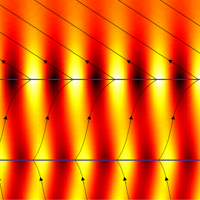Home > Press > Taming Tiny, Unruly Waves for Nano Optics
 |
| Waves of electromagnetic energy passing through a vacuum between two plates of silicon carbide just 100 nanometers apart, one at an elevated temperature. The lines represent the energy stream, bending the light as it is pushed through the small gap. |
Abstract:
Nanoscale devices present a unique challenge to any optical technology — there's just not enough room for light to travel in a straight line.
Taming Tiny, Unruly Waves for Nano Optics
Atlanta, GA | Posted on October 8th, 2007On the nanoscale, energy may be produced by radiating photons of light between two surfaces very close together (sometimes as close as 10 nanometers), smaller than the wavelength of the light. Light behaves much differently on the nanoscale as its wavelength is interrupted, producing unstable waves called evanescent waves. The direction of these unpredictable waves can't be calculated, so researchers face the daunting task of designing nanotechnologies to work with the tiny, yet potentially useful waves of light.
Researchers at Georgia Tech have discovered a way to predict the behavior of these unruly waves of light during nanoscale radiation heat transfer, opening the door to the design of a spectrum of new nanodevices (or NEMS) and nanotechnologies, including solar thermal energy technologies. Their findings were featured on the cover of the Oct. 8 issue of Applied Physics Letters.
"This discovery gives us the fundamental information to determine things like how far apart plates should be and what size they should be when designing a technology that uses nanoscale radiation heat transfer," said Zhuomin Zhang, a lead researcher on the project and a professor in the Woodruff School of Mechanical Engineering. "Understanding the behavior of light at this scale is the key to designing technologies to take advantage of the unique capabilities of this phenomenon."
The Georgia Tech research team set out to study evanescent waves in nanoscale radiation energy transfer (between two very close surfaces at different temperatures by means of thermal radiation). Because the direction of evanescent waves is seemingly unknowable (an imaginary value) in physics terms, Zhang's group instead decided to follow the direction of the electromagnetic energy flow (also known as a Poynting vector) to predict behavior rather than the direction of the photons.
"We're using classic electrodynamics to explain the behavior of the waves, not quantum mechanics," Zhang said. "We're predicting the energy propagation — and not the actual movement — of the photons."
The challenge is that electrodynamics work differently on the nanoscale and the Georgia Tech team would need to pinpoint those differences. Planck's law, a more than 100-year-old theory about how electromagnetic waves radiate, does not apply on the nanoscale due to fact that the space between surfaces is smaller than a wavelength.
The Georgia Tech team observed that instead of normal straight line radiation, the light was bending as protons tunneled through the vacuum in between the two surfaces just nanometers apart. The team also noticed that the evanescent waves were separating during this thermal process, allowing them to visualize and predict the energy path of the waves.
Understanding the behavior of such waves is critical to the design of many devices that use nanotechnology, including near-field thermophotovoltaic systems, nanoscale imaging based on thermal radiation scanning tunneling microscopy and scanning photon-tunneling microscopy, said Zhang.
####
About Georgia Institute of Technology
The Georgia Institute of Technology is one of the nation's premiere research universities. Ranked seventh among U.S. News & World Report's top public universities, Georgia Tech's more than 18,000 students are enrolled in its Colleges of Architecture, Computing, Engineering, Liberal Arts, Management and Sciences. Tech is among the nation's top producers of women and African-American engineers. The Institute offers research opportunities to both undergraduate and graduate students and is home to more than 100 interdisciplinary units plus the Georgia Tech Research Institute.
For more information, please click here
Contacts:
Megan McRainey, Institute Communications & Public Affairs
404-894-6016
Copyright © Georgia Institute of Technology
If you have a comment, please Contact us.Issuers of news releases, not 7th Wave, Inc. or Nanotechnology Now, are solely responsible for the accuracy of the content.
| Related News Press |
Discoveries
![]() Researchers develop molecular qubits that communicate at telecom frequencies October 3rd, 2025
Researchers develop molecular qubits that communicate at telecom frequencies October 3rd, 2025
![]() Next-generation quantum communication October 3rd, 2025
Next-generation quantum communication October 3rd, 2025
![]() "Nanoreactor" cage uses visible light for catalytic and ultra-selective cross-cycloadditions October 3rd, 2025
"Nanoreactor" cage uses visible light for catalytic and ultra-selective cross-cycloadditions October 3rd, 2025
Announcements
![]() Rice membrane extracts lithium from brines with greater speed, less waste October 3rd, 2025
Rice membrane extracts lithium from brines with greater speed, less waste October 3rd, 2025
![]() Researchers develop molecular qubits that communicate at telecom frequencies October 3rd, 2025
Researchers develop molecular qubits that communicate at telecom frequencies October 3rd, 2025
![]() Next-generation quantum communication October 3rd, 2025
Next-generation quantum communication October 3rd, 2025
![]() "Nanoreactor" cage uses visible light for catalytic and ultra-selective cross-cycloadditions October 3rd, 2025
"Nanoreactor" cage uses visible light for catalytic and ultra-selective cross-cycloadditions October 3rd, 2025
Photonics/Optics/Lasers
![]() ICFO researchers overcome long-standing bottleneck in single photon detection with twisted 2D materials August 8th, 2025
ICFO researchers overcome long-standing bottleneck in single photon detection with twisted 2D materials August 8th, 2025
![]() Institute for Nanoscience hosts annual proposal planning meeting May 16th, 2025
Institute for Nanoscience hosts annual proposal planning meeting May 16th, 2025
|
|
||
|
|
||
| The latest news from around the world, FREE | ||
|
|
||
|
|
||
| Premium Products | ||
|
|
||
|
Only the news you want to read!
Learn More |
||
|
|
||
|
Full-service, expert consulting
Learn More |
||
|
|
||








